5.4: Barriers to Voting
- Page ID
- 129160
The year 2020 impacted voter registration in a whole new way. It’s not often that a pandemic comes along and prevents voter registration, but as we see from the follow chart, when COVID 19 was peaking registration went down. You can see in Figure 5.11 that the months of April and May when COVID was at its height registration was at its lowest. Obviously during the months when Texas was in a shut down, in person registration was also down. It became a race by the parties to contact potential voters though email, text, and phone calls in order to get them registered.
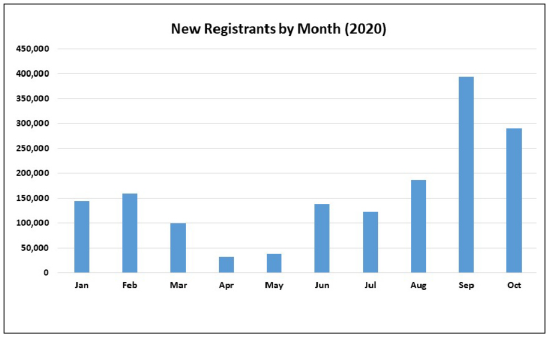
While the pandemic had an impact, anytime accessibility is limited or it is harder for people to vote, you discourage registration and voting. Barriers to voter turnout could be how long before the actual election that you must register to vote. States may require registration to take place as much as thirty days before voting, or they may allow same-day registration. Fourteen states and the District of Columbia now allow voters to register the day of the election if they have proof of residency, such as a driver’s license or utility bill. However, Texas requires registration forms to be mailed thirty days before an election. This means that requiring people to mail the ballot thirty days in advance can have a negative effect on voter turnout.
Other factors include socioeconomic status, obstacles to voting by mail, voter fatigue, and Republican dominance.
Socioeconomic Factors
Socioeconomic factors also play a role in low voter turnout. It’s much easier to vote if you are a salaried employee. If you are paid by the hour, however, then time is money. Voting takes time. Voters must drive from their place of employment to the polls and stand in what is often a very long line to cast a ballot and then drive back to work. So not only do many prospective voters not have time to vote but they cannot sacrifice the work (money).
Another factor in Texas is that many Texans who are eligible to vote do not speak English. Political Parties have been trying for a long time to mobilize the Hispanic voter, but they still have low numbers at the polls. Although Texas has bilingual voting places (Figure 5.12), Hispanics tend to feel less empowered and often are surrounded by other nonvoters, which reinforces the pattern of nonvoting. Also, many poor or working-class Hispanics are busy focusing on their immediate needs. As Juan Flores, a twenty-seven-year-old nonvoter says, “Being poor really doesn’t lend itself to fixing major problems.”26
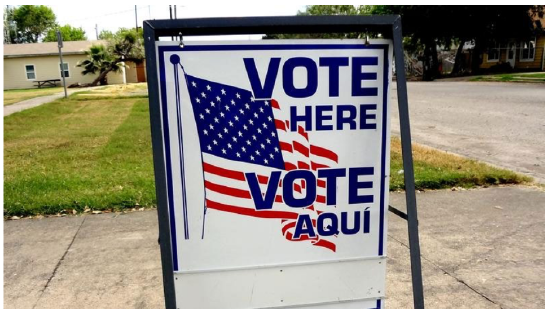
Is Texas’s Controversial Voter ID Law a Modern-Day Poll Tax?
Texas has one of the strictest voter ID laws out of all the states (Figure 5.13). In Texas you are supposed to show a photo ID to vote. Voters may use one of seven (7) forms of photo ID:
- Texas Driver license;
- Texas Election Identification Certificate (EIC);
- Texas Personal Identification Card issued by DPS;
- Texas handgun license;
- U.S. military identification card containing the person’s photograph;
- U.S. citizenship certificate containing the person’s photograph;
- U.S. passport.
For voters aged eighteen to sixty-nine, IDs may be expired up to four years. A person seventy years of age or older may use a form of ID that has expired more than four years ago.
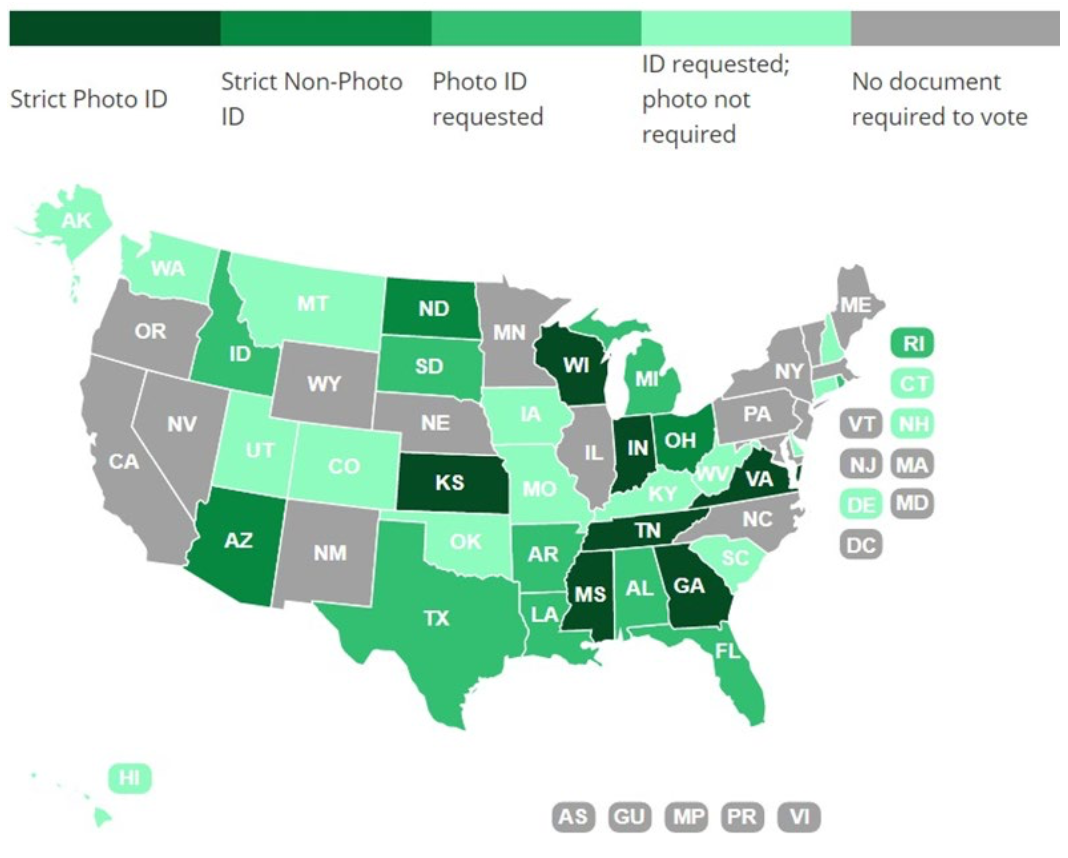
If you cannot obtain one of the seven forms of approved photo IDs, you still have the ability to vote. New procedures allow registered voters who are not able to obtain an acceptable photo ID to sign a simple, one-page form called the Reasonable Impediment Declaration and present one of the following documents to vote a regular ballot (Figure 5.14):
- valid voter registration certificate (card);
- certified birth certificate;
- current utility bill;
- bank statement;
- government check;
- paycheck;
- any other government document with the individual’s name and address.
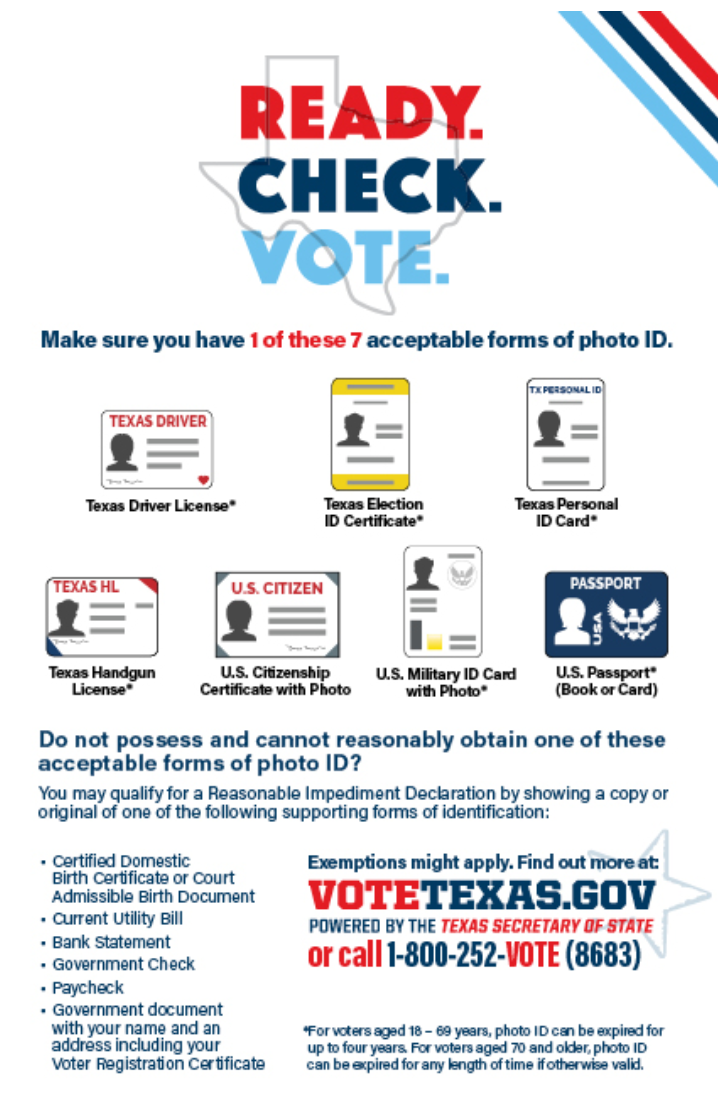
Minorities and the poor are most effected by the voter ID laws. Democrats argue that these laws disproportionally affect minorities (Figure 5.15). These voter ID laws have been called a “poll tax” because individuals have to pay for government identification in order to be able to participate.27 In 2014, 600,000 voters of 13.6 million registered voters (about 4.4 percent) in Texas did not have the proper form of ID to vote. In 2016, not much had changed. About 600,000 of Texas’s fifteen million registered voters lacked the type of ID required by the new law. In the 2020 election about 5.7 million Texans were registered to vote but did not.28 However, it is difficult to say how many did not vote because of a lack of ID versus the various other reasons discussed in this chapter that discourage people from voting.
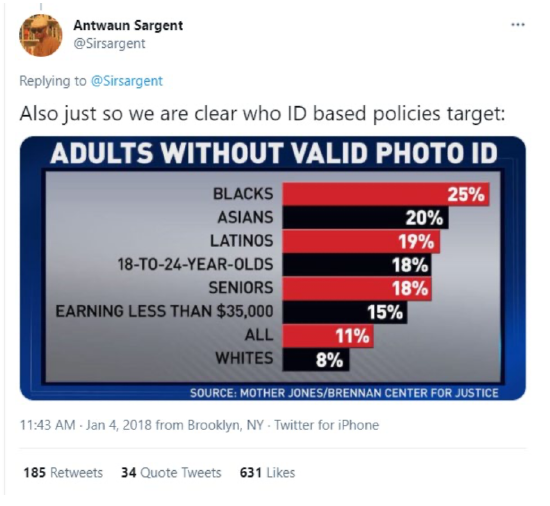
Republicans argue that these voter ID laws are necessary to protect the integrity of the ballot. Republican representative Dan Flynn co-authored Texas’s voter ID legislation in 2011. He says he’s motivated by a common sense belief: “Everybody gets to vote once, and you can’t be dead to vote.”29 His interest in voter ID requirements for Texas stem in part from a sense that citizens lack confidence in the election system, and voter ID legislation is one way to raise that confidence. The idea of utilizing restrictive voting laws to protect the ballot in Texas is an argument still made by the Republican Party. The Texas legislature has numerous bills that some argue will suppress minority voters (Figure 5.16). In the following tweet Texas House Representative Rafael Anchía schools the GOP representative Briscoe Cain on the Jim Crow roots of the language used in his 2021 purity-of-the-ballot-box bill (Figure 5.17).
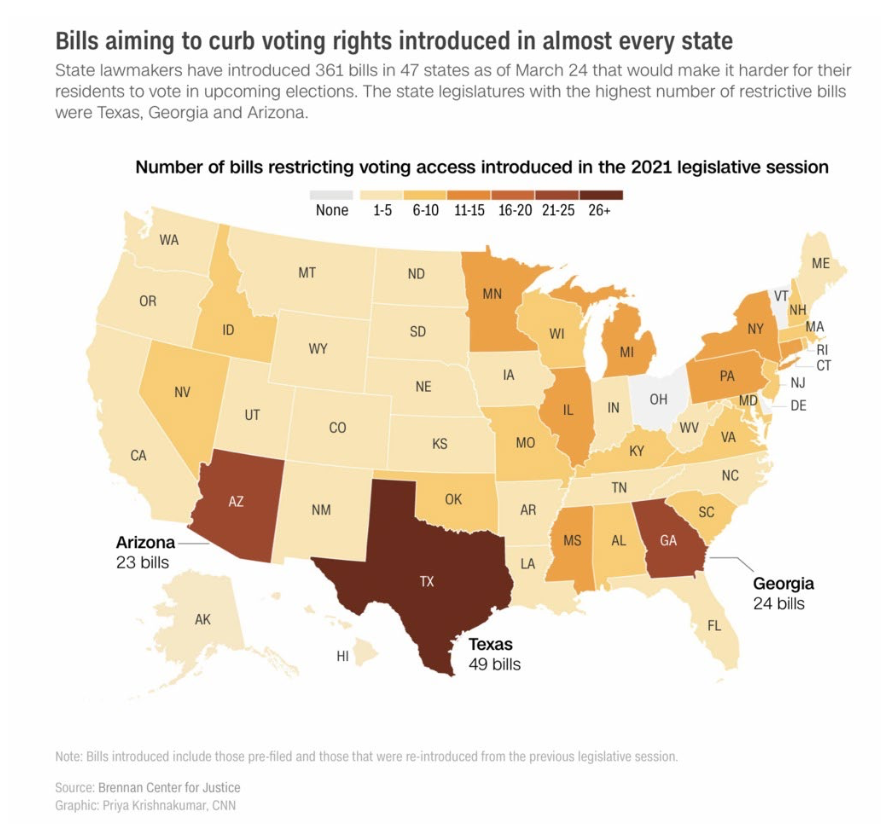
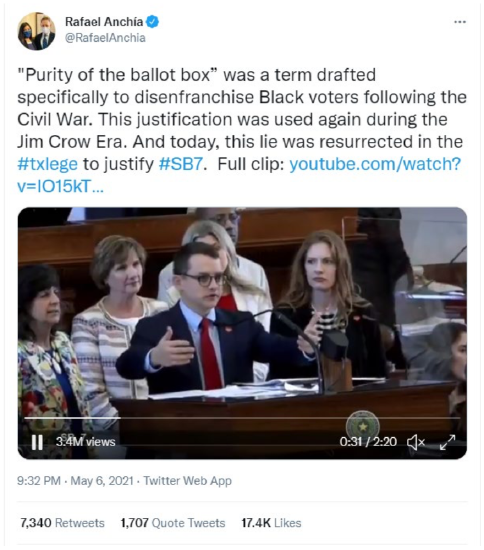
Obstacles to Voting by Mail
Since the 2020 COVID pandemic, many states have implemented steps to make voting easier and more inclusive. Texas is not one of those states. One of the options many states are making simple is voting by mail. However, in Texas it is not so simple. In order to vote by mail in Texas you must be sixty-five years or older, be sick or disabled, be out of the county on election day and during the period for early voting by personal appearance, or be confined in jail but otherwise eligible. If you meet the criteria, then you must fill out an application requesting a ballot by mail and submit it to the county clerk for your county. Remember politics is about power and keeping it. Those who are in power decide the rules of the game and who plays.
Voter Fatigue
Another significant factor affecting voter turnout is voter fatigue. Ignoring city or town and other local elections, Texas holds at least one statewide election every year and typically several. But many people just do not know the issues. They do not know who the candidates are, or what their policies are, and they might not care (apathy). So, this brings up the question, how do we fix voter apathy? In “The Joe Rogan Experience,” actor, comedian, and podcaster Joe Rogan interviews Larry Sharpe the New York candidate for the 2020 Libertarian vice president nomination to discuss how to fix vo ter apathy and get people to vote. Sharpe tells Rogan, it boils down to hope over fear: “you have to give them hope.”30
Republican Dominance
A third factor impacting voter turnout is the lack of competition between the political parties in Texas. Texas has a history of being a one-party state. Up until the 1960s that party was the Democratic Party, but that really began to change in the 1980s. In fact, since 1994 Republicans have won every single statewide office in Texas! Because of Republican domination in Texas, Democrats might think why bother to vote, and Republicans might think, well, Republicans are going to win whether I vote or not, so they show up in low numbers as well. Eligible voters might feel like their vote does not even matter; they do not vote if they do not feel a sense of efficacy.
So, Who Does Vote?
Ok, so you now know what makes voting more difficult and decreases voter turnout in Texas, so who is voting? Well, up until the 2020 elections older people were much more likely than younger people to vote. Older people understand the value of voting and have a vested interest in the outcome, political scientist Andrea Louise Campbell explains in a U.S. New and World Report analysis of the many reasons older citizens are more likely to vote:
It is easier for older people to see the relevance of government in their lives. Two of the biggest federal spending items, Social Security and Medicare, are conferred largely on the basis of age. . . For the nonelderly, it can be harder to recognize the relevance of government because it’s hidden behind hard-to-see regulation or hidden in the tax code.31
In addition to social security and Medicare, older people are more likely to consider factors like home taxes, for example. Also, older people are less mobile than younger people, meaning they and do not move as often and stay in the same residence. Because they have maintained their residence for a longer time, they are usually already registered and familiar with their voting locations and how the process works.32 Having lived in the same place for a longer time, older people feel a part of their community and therefore often “feel more connected to the political process” according to political scientist Eiten Hersh, who also notes that voting for older Americans is a part of their routine.33 Another factor is their neighbors and friends who are likely close to their age and are also voters which places societal pressures to vote.34 Older people are also members of interest groups like AARP, which reminds them that it time to vote.35 However, the 2020 election was different in Texas from previous years. Older people did not vote in numbers as large as they had in previous years, likely due to a fear of contracting COVID. Although many voted by mail, older people are more likely to vote in person rather than by mail, and there were many barriers to voting by mail in Texas. According to Chad Dunn, general counsel for the Texas Democratic Party, “Republican leaders were aggressive, and largely successful, in shutting down efforts to allow universal mail-in balloting and multiple mail ballot drop-off points that would have made it easier for voters to cast ballots while avoiding crowded polls.”36 In Figure 5.18 , you can see that 2020 saw an increase in voters in the eighteen to twenty-nine age category. See what conclusions you can draw from the graphs in Figure 5.18.
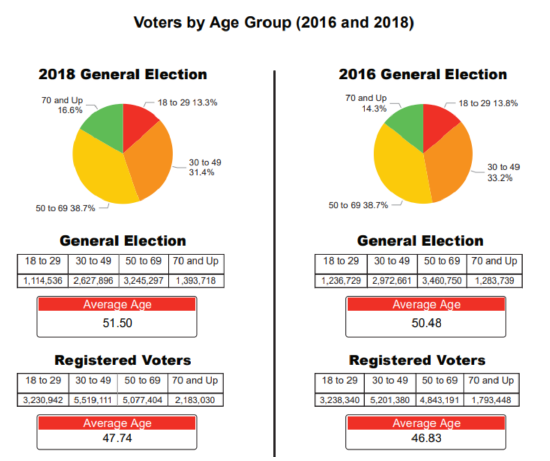
In Texas, women also vote slightly more than males as you can see from Figure 5.19. In this category, 2020 was consistent with previous years.
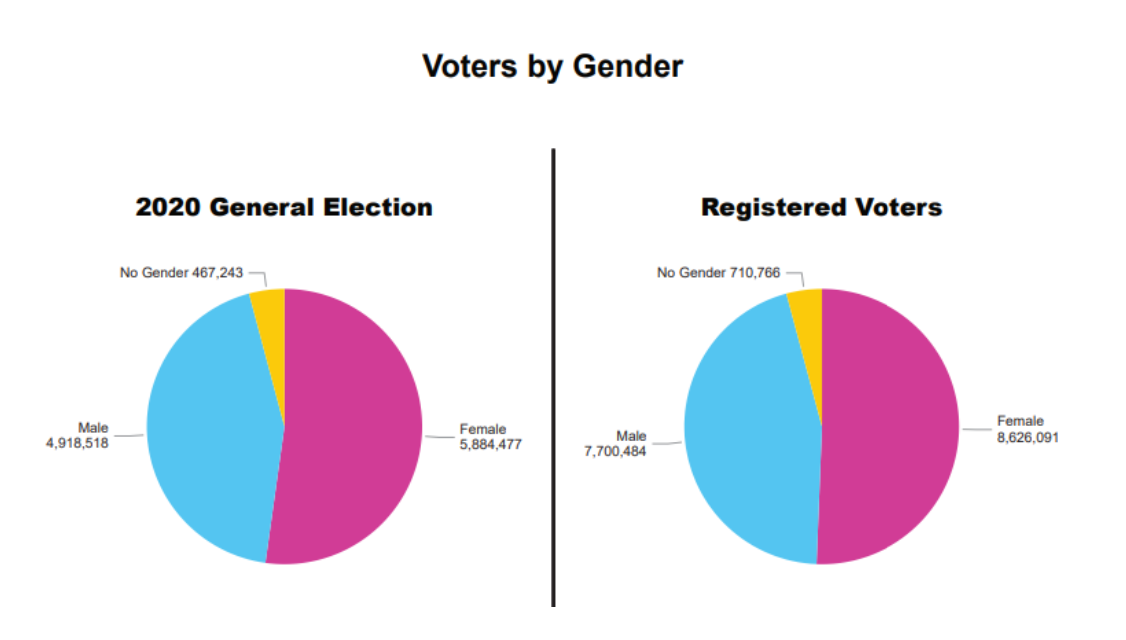
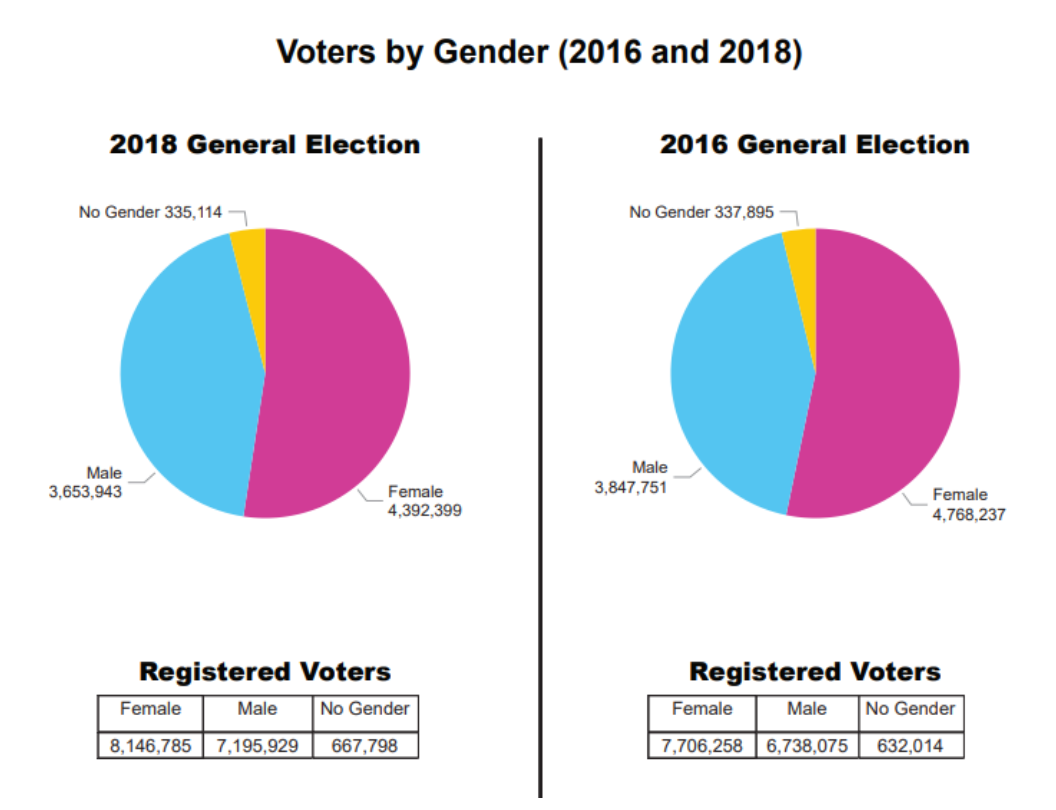
Whites are more likely to vote than other groups. However, there was a rise in both Black and Hispanic voting in the 2020 election—motivated in part by the higher death toll and economic impact from the pandemic on both groups37—and the Democratic Party put forth a large effort to these two groups. Hispanics make up about thirty percent of the Texas population but only about twenty percent show up at the polls. There is always talk of awakening the sleeping giant, which refers to mobilizing the Hispanic vote; however, this has not been an easy feat. There is an assumption that Hispanics will vote Democrat in the elections, but this has not consistently proved the case. Hispanics vote according to their personal preferences and that means that some vote Republican and some Democrat. So, although the Hispanic population is large enough to swing Texas blue, since they do not all vote as one, that is not as likely as it might seem. Although there were some counties where the Hispanic population voted for Biden, there were other areas where the Hispanic population voted in support of Trump. As for Black voters in Texas, many new voting laws have the potential to negatively impact Black voters, such as the availability of polling locations in urban areas and redistricting efforts in 2021.
26. Cecilia Ballí “Don’t Call Texas’s Latino Voters the ‘Sleeping Giant’—They’re Not Disengaged—They’re Waiting To Be Heard, and Fully Understood,” Texas Monthly, Nov. 2020, https://www.texasmonthly.com/news-po...g-giant/.balli.
27. Paul J. Weber, “Judge Again Throws Out Texas ID Laws Backed by Trump, Compares Law to ‘Poll Tax,’” Chicago Tribune, Aug. 24, 2017, https://www.chicagotribune.com/natio...823-story.html.
28. Karen Brooks Harper, “Despite Record Turnout, Some Texas Voters Sere Still Shut Out,” Texas Tribune, Nov. 6, 2020, https://www.texastribune.org/2020/11...ccess-turnout/.
29. “Voter ID: Pros, Cons, and Costs,” National Conference of State Legislatures, Apr. 2011, https://www.ncsl.org/research/electi...and-costs.aspx.
30. Joe Rogan, host, “The Joe Rogan Experience #1167 - Larry Sharpe” (podcast), Sept. 5, 2018, https://podscribe.app/feeds/http-joe...801163b631a585.
31. Mary Louise Campbell, quoted in Emily Brandon, “Why Older Citizens Vote,” U.S. News and World Report, Oct. 5, 2020, https://money.usnews.com/money/retir...likely-to-vote.
32. Brandon, “Why Older Citizens Vote,” https://money.usnews.com/money/retir...likely-to-vote.
33. Eiten Hersh, quoted in Brandon, “Why Older Citizens Vote,” https://money.usnews.com/money/retir...likely-to-vote.
34. Brandon, “Why Older Citizens Vote,” https://money.usnews.com/money/retir...likely-to-vote.
35. Brandon, “Why Older Citizens Vote,” https://money.usnews.com/money/retir...likely-to-vote.
36. Chad Dunn, as quoted in Harper, “Despite Record Turnout, Some Texans Were Still Shut Out,” https://www.texastribune.org/2020/11...ccess-turnout/.
37. Taylor Pettaway, “Experts Say More Blacks and Latinos Are Voting in Texas This Year. Here Is What Is Motivating Them,” MySA, Nov. 3, 2020, https://www.mysanantonio.com/news/lo...s-15694876.php.

